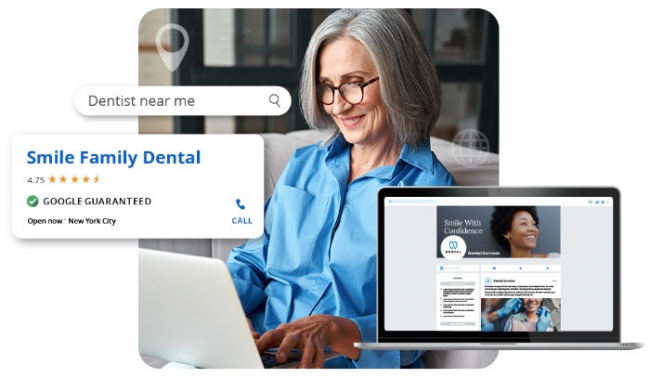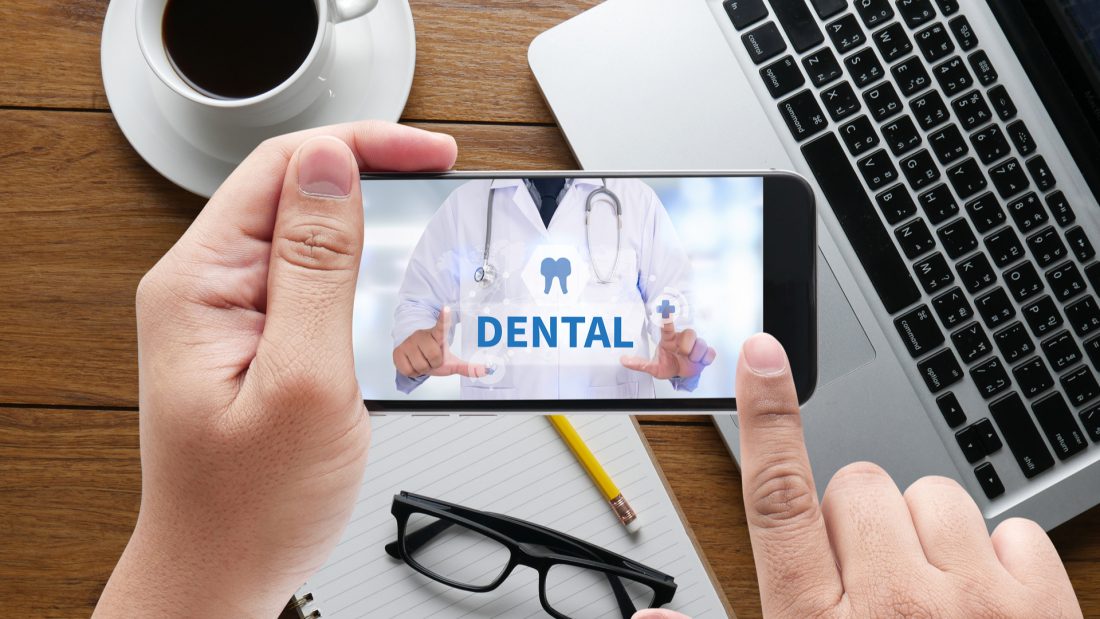Searching for essential information to improve your dental marketing? Don’t feel like wading through an ocean of online information to find it? This time-saving guide provides the answers—the five best ways to optimize your dental marketing campaigns for improving patient experience and growth.
Designed to increase your brand authority, patient trust, and advertising efficiency, this guide will help you identify which marketing channels are most efficient and a marketing budget to put your dental marketing into action to increase patient inquiries, conversions, and patient loyalty.
The latter three rewards naturally explain the why behind dental marketing. Yet to get to the rewards, it’s important to first understand a bit more about a central preparatory question:

What is dental marketing?
Most (if not all) forms of dental marketing boil down to actions taken by your dental practice (whether through posts on social media or through your dental website) to compel a potential patient to say yes to something:
- Yes, I like this dental practice
- Yes, I want to find out more about this dental practice
- Yes, I want to contact this dental practice and ask about becoming a patient
- Yes, I want to remain a patient of this dental practice
- Yes, I feel comfortable recommending this dental practice to a friend or family member
Such yesses (representing marketing goal realization) effectively sit at the center of a fulcrum in the minds of potential patients, meaning they can certainly say yes to something. Yet they can equally tip the other way and say no.
Tipping the fulcrum in favor of people saying yes to your practice involves knowing a key marketing equation:
The force of the actual or perceived value of something must outweigh the force of the actual or perceived cost.
Within a dental context, the value of your dental practice in the minds of potential and existing patients must be greater than the value presented by competing practices. Inversely, costs must be lower than competing practices, and costs go beyond dollars attached to the price of dental exams and procedures.
Here’s an example.
In an increasingly online world where people are accustomed to doing many things with a click, recent data published by Zippia unsurprisingly found that 67% of patients prefer online booking. Given the busy lives that people lead, 34% of scheduled appointments are made after hours, and since 97% of Americans now own a smartphone (with over 6 billion smartphone users worldwide), few dental practices should be surprised that more than half of appointment bookings (54%) made during work hours are made on the go.
In other words, time-savings and convenience represent value for most people. Inconvenience and time-consuming tasks represent cost. So, if you offer potential and existing patients the quick convenience of tools like online forms and online bill payment (which also save staff time) and competitors don’t, you tip the fulcrum in your favor by offering what people now want from dental practices.
Therefore, such tools become marketing assets—values/differentiators to publicize in your dental marketing campaigns for improving patient experience and growth because they offer many benefits.

What are the benefits of optimized dental marketing campaigns?
Though dental marketing campaigns can vary in scope, nature, and method to reach people, dental marketing campaigns tend to deliver five key benefits:
- Stronger brand authority
Brand authority refers to the level at which potential and existing patients view your dental practice as trustworthy and reputable. This explains why brand authority is also known as brand reputation, and the more you get in front of people through dental marketing campaigns and interact with them, the more you help strengthen your brand reputation. As an example, a recent Forbes Insights report found that over 50% of brand reputation comes from online sociability.
To underscore the importance of overall brand reputation for dental practices, DentistryIQ recently quoted Richard Branson, who said, “Your brand name is only as good as your reputation.” When practices manage their brand reputation correctly (as noted by Dental Economics), practices drive new patient growth and therefore more revenue. Neglect brand reputation and, in a competitive dental market, competing practices that are minding their brand reputation may attract potential patients that could have been your patients.
A solid starting point to ensure your brand reputation is on point is to ask yourself, “Does my dental practice cohesively present itself?”
- Do the colors of your website and logo match?
- Does the tone of your social posts match the tone of your website content?
- Do you use consistent fonts in your dental marketing campaigns?
Asking yourself such questions helps develop brand cohesiveness, which factors prominently in brand reputation and dental marketing campaigns. If a potential or existing patient should do a side-by-side comparison of your Facebook page and website, for example, they should instantly know that they’re looking at the same dental practice.
“When you’re advertising your business,” writes entrepreneur and best-selling author Kristopher Jones in a March 2021 article for Forbes, “you want everything to be cohesive,” adding, “If you’re advertising without solid branding, you’re missing out on a lot of great opportunities to create an effective campaign.”
- Increased patient loyalty
Newton’s First Law of Motion states that an object at rest tends to stay at rest and an object in motion tends to stay in motion, meaning it generally takes far greater force to propel something than it does to keep that movement happening. Though seemingly disconnected from terrestrial matters, Newton’s First Law of Motion aligns with dental practice marketing and revenue.
Think of money spent on dental marketing campaigns as a force. Though acquiring new patients will always be cornerstone to dental practice growth, it generally takes greater force to reach potential patients and propel them toward your dental practice than it does to retain existing patients (or patients already in motion). According to Harvard Business Review, “Acquiring a new customer is anywhere from five to 25 times more expensive than retaining an existing one,” and improved patient retention holds better revenue potential than dental practices may realize. According to research by Bain & Company, “By increasing retention by as little as 5 per cent, profits can be boosted by as much as 95 per cent.”
So, increased patient loyalty from dental marketing campaigns holds substantial benefits because that loyalty doesn’t just include how much they may spend today at your dental practice. It includes how much they may spend in the future. As customer experience futurist and author Blake Morgan writes in Forbes, “When considering how much to spend to create or retain customers, it’s important to consider a customer’s lifetime value, or CLV.” Acknowledging that this number is different for individual companies, Morgan adds, “Companies that consider the potential of a customer—for the future—are much better off.”
- Greater patient trust
Polish-born American psychologist Robert Zajonc was the first person to demonstrate in a lab setting what would be called the familiarity principle (a.k.a. the mere-exposure effect). Simply stated, the more a person is exposed to something (excluding harmful things, naturally), the more a person trusts that something, and it works the same way in marketing. The more a potential patient gets to know your dental practice through dental marketing campaigns, the greater their trust builds until they’re ready to reach out to your dental practice and make an appointment.
The good news: Trust in dentists remains at a high level, which is remarkable considering that trust toward other industries and governments has taken a nosedive.
- “We find a world ensnared in a vicious cycle of distrust, fueled by a growing lack of faith in media and government.”—2022 Edelman Trust Barometer
- “87% of executives think customers highly trust their companies when only about 30% do.”—PwC’s 2022 Consumer Intelligence Series Survey on Trust
- “The trustworthiness of technology companies has declined from 38% to 34%… the conventional wisdom about trust is still that it is in crisis.”—Ipsos (January 2022)
In contrast, trust levels are high for dentists and have been so for years, exampled by Gallup’s Honesty/Ethics in Professions survey.
In 1981, 52% of respondents said they had high or very high trust in dentists. In 2019, 61% of respondents said they had high or very high trust in dentists. Overall, according to Gallup surveys conducted from 1981 to 2019, trust in dentists has stood in the 50-60% range, ranking dentists alongside nurses, engineers, medical doctors, and pharmacists in high trust levels.

So, what’s the significance of this to your dental marketing campaigns?
It all ties back to earlier information in this blog about motion and force. For many people that you’ll reach with your dental practice marketing, a general level of high dental trust already exists. It’s already in motion, meaning you don’t have to overly expend marketing force to create trust. You simply need to get in front of potential patients more often on a consistent basis and boost familiarity so that more patients direct their trust (and eventually appointments) to your dental practice instead of competing practices.
- Increased marketing efficiency
The less time and money your dental practice spends to acquire new patients, the more efficient your dental marketing becomes and the greater the potentials for increased revenue. The latter is naturally a key benefit of an optimized dental marketing campaign, and businesses often use complex equations to determine marketing efficiency. Yet here’s a simple social media example of how marketing efficiency serves your bottom line, beginning with some important statistics.
Almost half of practices (45%) are planning more organic social posts in 2023, according to our newly released 2023 State of Dental Marketing Report, which makes sense given social media’s reach.
- Facebook ranks top in popularity with nearly 3 billion users. (Social Media Today)
- Instagram has over 2 billion active users. (Social Media Today)
- The global number of social media users is expected to reach nearly 6 billion by 2027. (Statista)
To keep step with competitors marketing on social media, you have two choices:
- You can appoint someone at your practice to make regular posts
- You can hire a social media management service specializing in dental marketing to handle it for you
Here’s how the two options compare using real-world numbers:
Option 1 – Someone at your practice can making regular posts on social media
If your dental office manager earns $35 per hour, handles social media, and spends three hours per week creating and making posts, the cost in time and labor to your practice is $420/month (at a four-week month) or $5,040/year.
Option 2 – Hiring a social media management service to handle it for you
If you use ProSites’ social media management service at $345/month, you save $75/month (at a four-week month) or $900/year.
The thing to keep in mind: Option 1 doesn’t take certain realities into account. As busy as practices can be, days will inevitably occur when there’s no time to push out social posts, or posts will be rushed out at the wrong time of day to optimally reach potential patients. This means, while the $420/month figure remains fixed, returns on fluctuating marketing efficiency may vary.
When you choose Option 2, you realize three benefits: Your costs per month go down, staff can focus on the business of patient care and work, and your social media cadence remains consistent, and even marginal differences in consistency can yield larger returns for your dental practice when you consider how much patients spend on average in a year.
According to the American Dental Association (ADA), patients spent $653 on average per year. If your practice lands 50 new patients in a year through self-managed social media posts, and you allow for 20% attrition:
- 40 new patients X $653 = $26,120/year
If you optimize your dental marketing campaigns on social by using social media management and land just 10 more patients in a year by leveraging greater consistency with done-for-you posts:
- 50 new patients X $653 – $32,650/year
That’s an ROI difference of $6,530 from increased marketing efficiency, which brings this section full circle. The less time and money your dental practice spends to acquire new patients, the more efficient your dental marketing becomes and the greater the potentials for increased revenue.
- Increased patient inquiries and conversions
Attracting prospective patients to your dental practice and converting them into paying patients are naturally two prime benefits when you optimize your dental marketing campaigns, and marketing tools like a professional-looking dental website are certainly essential to reach those goals. Yet the effectiveness of marketing tools involves more than the mechanics behind those tools. The effectiveness of marketing tools is ultimately determined by how you view them and what you make of them.
Here’s an example.
Imagine two dental practices. They offer the exact same services in the same city. Both practices are equal in facilities and staff. Indeed, if a potential patient was to physically visit both practices and compare them against each other, that prospective patient would have no reason to choose one practice over another. Yet most prospective patients aren’t in the habit of physically visiting practices or most other businesses to gather first impressions.
In an increasingly online world, 80% of people search online for information on local businesses and services. This means, your website will be the first thing most prospective patients see, and in our scenario, this is where the two example practices differ.
- The first practice has a clean, modern website with easy, intuitive navigation and up-to-date content. It looks fresh and inviting and reflects what prospective patients can expect when they make an appointment.
- The second practice has an older website design with confusing navigation and content that hasn’t been updated in quite a while. It looks dated and out of touch, which doesn’t reflect the modern nature of the practice itself.
If you suspect most people would choose the first practice’s website, your answer aligns with what research shows:

First Impressions Count
You only have seconds to make a good first impression with your website, and according to web credibility research by Stanford University, the overall look of a website is the #1 factor related to any company’s perceived trust and credibility. “Without trust,” says a similar research published by ResearchGate, “no transaction takes place,” meaning companies with websites designed for trust have a strategic advantage over competitors.
In other words, since most marketing channels flow directly to your practice website, having one that instantly makes a good first impression is paramount to the success of dental marketing campaigns.
Simple Navigation Matters
Whether ordering food online or tickets to a show, you know how aggravating it can be when you can’t find things quickly, and it’s the same thing when prospective patients visit your website. They want to find information quickly about who you are, the services you offer, and how to book an appointment, and if they’re hindered by complex, confusing navigation, they’re going to bounce.
- According to a recent survey by Clutch, 94% of people want easy website navigation.
Current Website Content Also Matters
If you haven’t updated your website content in a while, you may unknowingly be missing out on opportunities to land new patients. Recent research published by HubSpot shows that website visitors will quickly abandon a site if the content is outdated, and 50% of website visitors will permanently leave a site if the content is irrelevant.
“People assign more credibility to sites that show they have been recently updated or reviewed,” writes Relevant Insights. So, ensuring that your website content is current and relevant is a key part of how to optimize your dental marketing campaigns. When people land on your website, you want to do all you can to help ensure they remain on your website.

The Best Ways to Optimize Your Dental Marketing Campaigns for Improving Patient Experience and Growth
We’ve covered what dental marketing is and the benefits of optimized dental marketing campaigns, and we’ve touched on the importance of having the right tools realize those benefits. To bring this into greater focus, here’s more of an actionable execution plan—the best five ways to optimize your dental marketing campaigns for improving patient experience and growth:
Identify the Right Marketing Budget
To remain competitive, identifying the right monthly marketing budget involves knowing what competing practices are spending, detailed in our 2023 State of Dental Marketing Report:
- Relative to 27% of respondents who budgeted $500-$1,000 per month for marketing in 2022, about the same number of respondents (25%) budgeted more ($1,000-$5,000) per month for marketing.
- Of the 10% of respondents who reported making $1 million or more in annual revenue, over one third spend more than $1,000 per month on marketing.
- Practices making $1 million or more per year are planning on spending more on monthly marketing in 2023 than overall findings across all budget categories.
Audit Your Existing Marketing Campaigns
Auditing your existing marketing campaigns involves taking a hard, impartial look at what has worked in the past and what may be less effective going forward, like word-of-mouth advertising.
Practices have long relied on word of mouth to land new patients, and word of mouth will certainly remain important to practices. Yet things have changed dramatically in the past year. Where 80% of practices considered word-of-mouth advertising to be the most important marketing method in 2022, only 25% of practices consider word of mouth to be the most important marketing method in 2023 in an increasingly online world.
Prioritize Quality Marketing Channels
Quality channels are those that generate more quality leads than other channels, like online reviews featured on your practice website. According to BrightLocal, 79% of people trust the social proof of online reviews as much as personal recommendations. Given their effectiveness, 27% of practices are planning to cultivate more patient reviews and featured them on their websites (a marketing channel) to increase leads and conversions. So carefully consider where you’re prioritizing your marketing efforts.
Automate Your Marketing Tasks
Automating your dental marketing wherever you can not only helps ensure efficiency and consistency in getting in front of prospective patients when competing practices are doing the same. Automating your dental marketing saves time, which represents real-world dollar savings against the time and labor costs of handling it yourself and allows more time to focus on patients.
Focus on Patient Retention
As explained earlier under Increased Patient Loyalty, acquiring a new patient is more expensive than retaining an existing one, and holds considerable revenue potential. So, when making marketing and execution plans, make sure you utilize the right marketing tools for a balanced marketing approach that includes both prospective and existing patients.
Conclusion
Navigating the shifting landscape of online marketing holds the potential for tremendous rewards. Yet staying on top of the shifts to execute effective marketing takes time, which is why 58% of dental practices now use an online marketing service provider like ProSites.
Trusted by over 7,500 dental and medical professionals and endorsed by 15 state dental associations, our powerful and comprehensive suite of website design and internet marketing services provide practices with the tools needed to take their online presence to the next level. With ProSites, dental and medical professionals can reach more potential patients, strengthen engagement with current ones, and ensure the highest standards of patient care.
We’re committed to helping practices achieve measurable results and expand their reach to build a lasting connection with their online community, and we’re here to do the same for your practice.
What kind of ROI can you expect from us?
>> Visit us online today to find out







